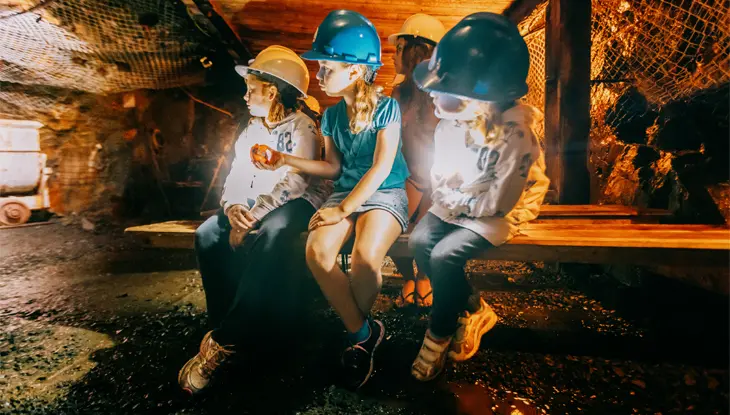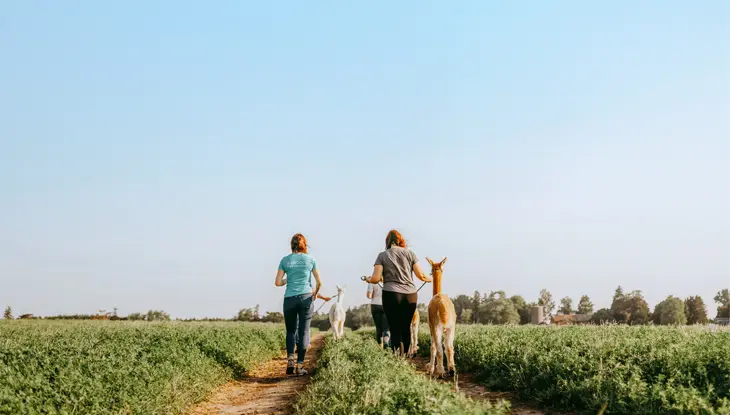Safari Niagara
Safari Niagara is a privately owned and operated nature and wildlife park that is home to over 1,000 animals, including birds, reptiles and mammals.
This 40-hectare park welcomes visitors to view animals from across the globe, including rhinos, lions, alpacas, camels, monkeys, cougars, giraffes, red pandas, zebras, reindeer and hippos. In addition to meeting the many park residents, exciting activities and attractions like a splash pad, kid’s rides, rope courses, jumping pillows, pedal bike go-karts and fishing will keep kids entertained all day.
Safari Niagara plays an important role in preventing the disappearance of endangered species through breeding programs and education.
Stevensville | Safari Niagara
How to get to Safari Niagara
Location: 2821 Stevensville Road, Stevensville
By car: Safari Niagara is approximately a 15-minute drive south of Niagara Falls via the QEW and Regional Road 116, and parking is free. Get detailed driving directions and a park map.
By transit: GO Transit provides train and bus service to Niagara Falls. You’ll need to take a local taxi to Safari Niagara in Stevensville.
Know before you go
Safari Niagara is a seasonal attraction open from May to October. From early June to the beginning of September, the park is open daily from 9:30 a.m. to 6:00 p.m. The park operates on shortened hours for select days in the spring and fall and hosts special events off-season.
Purchase tickets online or onsite for day admission, season membership or special events.
For your safety and the safety of the animals, review the Zoo Rules before you visit.
Things to do at Safari Niagara
Discover more activities and experiences.
Learn about the animals
Learn about the different species at a keeper talk or with a behind-the-scenes tour hosted by informative zookeepers and get up close to animals at Papa Steve’s Family Farm.
Tour the park by tram
Hop aboard the open-air Gator Express tram tour for a narrated ride through nine designated areas with information about the animals and history of the park.
Enjoy water activities
Try your hand at catch-and-release fishing in the pond or get out on the water with fun paddle boats.
Navigate an obstacle course
Test your climbing skills on a multi-level, nine-metre-tall course of balance beams, bridges and ropes at SkyQuest ropes course.
Splash, ride and play
Cool off at the fully accessible splashpad, which opens mid-June. Explore the retro carnival rides and visit the children’s play area featuring slides, swings and a carousel.
Check out fun events
From the summer rock concert, Safari Rocks to the popular Safari Niagara Lights and a drive-through holiday light adventure, keep an eye on the calendar of special events.
Articles and itineraries
Get ideas and inspiration for your next trip.

Interesting facts about Safari Niagara
The Tykolis, the founding family and owners of Safari Niagara began operating their first business in 1967.
Through innovative thinking and mindful investments, they developed Safari Niagara into the successful park it is today. The family transformed a flat, clay tract of land in rural Stevensville into a natural green space complete with hills, lakes and forests where animals can thrive.
Safari Niagara is home to Canada’s largest steel sculpture collection, created by artist Rod Dowling. Various steel sculptures of all shapes, sizes and colours can be found around the park grounds.
Accessibility Features
Ramps
An inclined plane that allows wheelchair users and others to access buildings and navigate between different levels.
Wide doorways and hallways
A sufficiently wide, hard-surfaced, unobstructed path to allow for easy travel.
Automatic doors
Main entrance doors and other accessible entrances and exits are power assisted to allow easy access.
Accessible restaurant
Designed to be accessible to persons with varying disabilities, including those using mobility aids. They include an accessible entrance, adequate maneuvering space, nearby accessible washrooms, tables with removable chairs and sufficient knee clearance, menus in alternate formats, and cafeteria or buffet counters that are reachable for mobility device users.
Accessible seating
For persons using mobility aids, accessible seating is available in all areas or levels for persons using mobility aids. The path to the accessible seating should be barrier-free so a person using a mobility device can access it. Reserved space with a clear view of the event/activity for someone who is seated, good sound quality and adequate maneuvering room for a mobility device.
Easy access electrical outlets
At least one electrical outlet is within easy reach and has clear floor space in front for charging an electric mobility device.
Accessible outdoor eating area
Places located outside where members of the public can sit at a table and eat (for example, outdoor food courts at amusement parks or picnic tables in parks). This includes accessible tables with enough clear space around and under so that people using a wheelchair or other mobility aid can easily access. Also, the ground leading to and under the accessible tables is level, firm and stable.
Information available in alternative format
Alternative formats present information beyond standard text, such as electronic text, audio, captioning and Braille. Accessible formats are available for menus, brochures, maps, signage or websites. Communication support must be provided in a timely manner upon request, at no extra charge, in consultation with the person making the request.
Support persons welcome
By law, you must allow a person with a disability to be accompanied by his or her support person while in the areas of your business that are open to the public. A support person is an individual hired or chosen by a person with a disability to provide services or assistance with communication, mobility, personal care, medical needs or with accessing goods, services or facilities. If you charge an admission fee at your business, you must let people know you charge an additional fee for a support person.
Service animals welcome
Can be identified by visual indicators (such as a vest or harness) or documentation from a regulated health professional confirming the animal is necessary due to a disability. In Ontario, service animals are allowed in all public spaces unless otherwise prohibited by law. A service animal is not a pet; it is trained to perform tasks to assist a person with a disability, such as guiding individuals with vision impairments, alerting to sounds for those with hearing impairments, assisting during seizures, retrieving items, or helping manage psychiatric and neurological disabilities. There are no restrictions on the type of animal used as a service animal in Ontario. If the animal is not easily identifiable, the person can provide documentation from a regulated health professional confirming the need for the service animal.
Accessible parking space
Accessible parking provides a place for people with disabilities to park and space to get in and out of their vehicles safely. It also provides access to the main accessible entrance and/or any other accessible entrances. Most users of wheelchairs need at least three feet of clearance to get in and out of their vehicles.
Accessible drop off location
A designated and signed area used for loading and unloading passengers into or out of a waiting vehicle. A passenger drop-off/pick-up area typically should include a driveway, a lay-by for the stopped vehicle close to an accessible entrance and an accessible route from the drop-off/pick-up area to the main entrance. It is important that any drop-off locations are clear of snow and ice or other obstructions.
Accessible vehicles operate on site
Transportation is available onsite and should include handrails, grab bars, and either have low floors or be equipped with a ramp.
Accessible washroom
At least one washroom stall larger than the others to accommodate adequate maneuvering space for mobility devices. They also include grab bars, transfer space, an accessible door latch, sink with knee clearance, and lever handles or automatic sensor faucets.
Accessible recreation trails
Trails with a firm and stable surface, designed to be accessible for individuals of all abilities. These trails are intended for public use, offering opportunities for leisure and recreation. To qualify as an accessible recreational trail, your site must have at least one such trail that is regularly maintained.
Last updated: September 2, 2025












